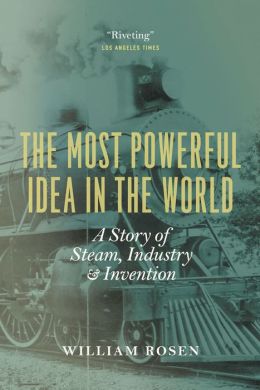Saturday, April 06, 2013
Another Book on the Evolution of Technology -- Revolutionary Technological Change
I just finished reading The Most Powerful Idea in the World: A Story of Steam, Industry, and Invention by William Rosen. Rosen suggests that perhaps 100 inventors produced the key inventions that transformed technology during the industrial revolution, of perhaps 10,000 inventors who contributed to the immersion of steam engines, the automation of cloth manufacture, railroads, steamboats, and the industrial mining of coal and iron ore and the industrial production of iron and steel.
Rosen focuses the book on the development of steam engines, machine tools, and spinning and weaving machines. He does not specify specific dates for the Industrial Revolution, going back in forth in time in his chapters according to the specific technology in question in each.
He discusses, Thomas Newcomen James Watt, Richard Arkwright, Samuel Bentham, Joseph Bramah, Oliver Evans, the two John Kays, Henry Maudslay, William Murdock, George and Robert Stephenson and Richard Trevithick among others. Given the importance of the inventions of these men, if you don't know who they were and what they did, read the book!
Rosen properly traces the technological developments of the industrial revolution to roots in ancient and medieval technology and to the accumulation of scientific knowledge over the centuries. He correctly portrays technology building upon earlier technology, with thousands of small improvements being made to transform an invariably inefficient embodiment of an transformative idea into an industrially efficient system.
He recognizes that the interconnections between needs for new technologies and market opportunities with the development of technology. Thus the depletion of forests led to the use of coal for fuel, which in turn led to the need for efficient pumps to keep the water out of mines. The availability of raw cotton and the ability to transport cotton fabric to distant markets led to the mechanization of cotton spinning and weaving. The military needs of the army, especially during the Napoleonic wars, led to growth of the iron industry and of automatic tools for boring cannons and making the blocks for rigging sailing ships. The need for better, more efficient transport led to the development of smaller, more efficient steam engines, railroads and steam ships. These interacted, increasing demands for iron and steel, coal and coke, transportation and manufactures.
Rosen focuses the book on the fundamental question: why did the industrial revolution start in England and spread primarily to countries such as the United States, Canada, Australia and New Zealand. After all, there were other countries that experienced the Renaissance and Enlightenment, that had relatively large groups of scientists and artisans. China had many of the bases for an industrial revolution long before they were present in Europe, but failed to make the revolutionary step (until much later).
Rosen fixes on patent law which added "the fuel of interest to the fire of genius". English patent law was in place at the beginning of the 18th century. Patent protection gave the new class of educated artisans the incentive to invent by profiting from monopolistic control of their inventions for 14 years, but also shared the knowledge of the inventions widely so that others could build upon them. He also notes the introduction of detailed measurement, so for example, people could effectively compare inventions and technologies in order to choose the more efficient from among alternatives.
I would add that the British had gone through civil wars in the 17th century and had a more stable government as compared with the French; the French Revolution and Napoleonic Wars were not conducive to an Industrial Revolution. Since the time of Cromwell the British government had been pro trade, and Britain was developing a colonial empire that provided raw materials to its factories and markets for its products, Rosen suggests too that there is a "just right" size for a country to have benefited from patent law; too large and innovative clusters did not arise naturally, too small and the market would not sustain inventions before they were taken by other countries. One might also say that there was a pattern in the general culture -- literacy, the Protestant ethic, lack of stultifying bureaucracy, more widely spread political authority -- more conducive to that Revolution.
Looking at the second industrial revolution (electrification, internal combustion engines, assembly line manufacturing, chemical industries) and the Information revolution (electronics, computers, communications, the Internet, automation) we might also point to the clustering of inventions in innovation systems around emerging technical opportunities. This has been called the long wave approach. In the Industrial Revolution, the opportunities created by steam power, coal, and iron and steal allowed many inventions to improve manufacturing and transportation. The country that got a lead in exploiting these opportunities had a significant advantage.
Here is another review of the book.
Labels:
book review,
History,
Technology
Subscribe to:
Post Comments (Atom)


No comments:
Post a Comment